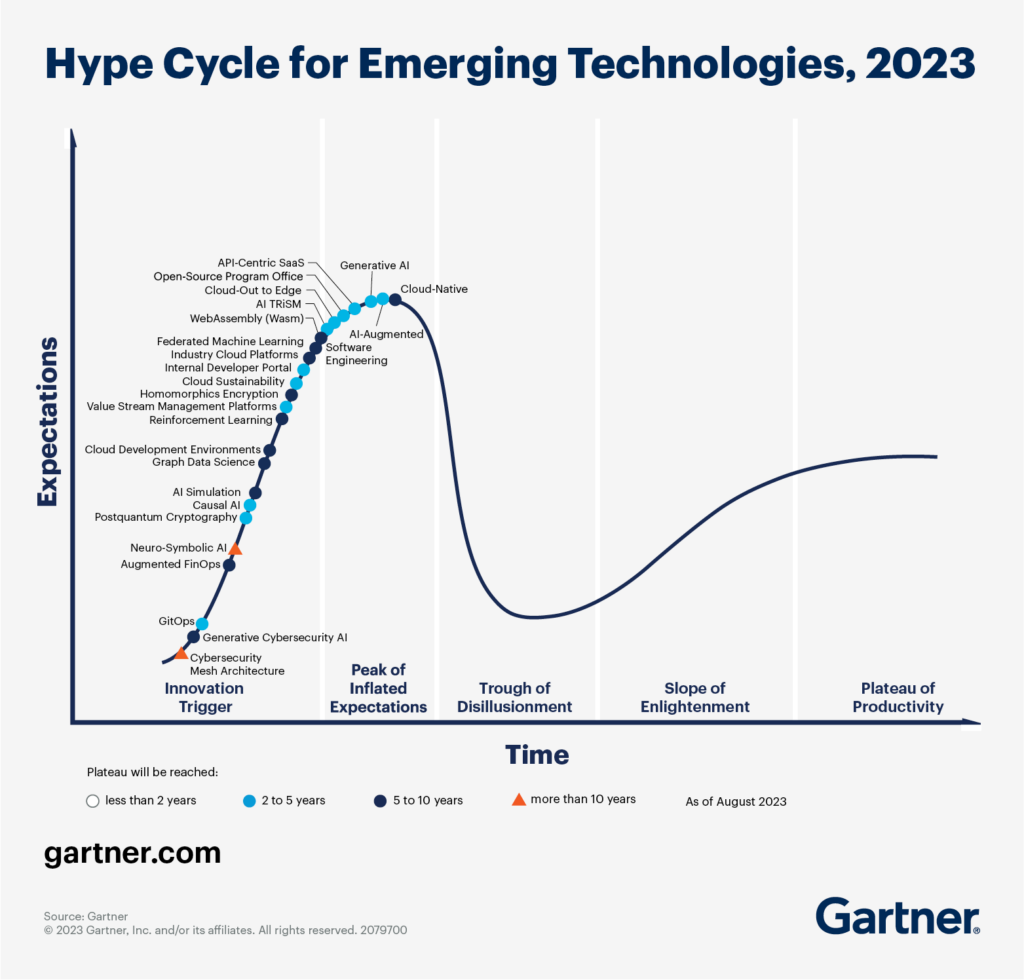
Let’s make one thing clear: We’re definitely not Luddites. We love technology as much as anyone, and in fact most of our clients are technology companies. We’re genuinely excited aboutartificial intelligence (AI) and actively exploring its potential uses in our work as well as following the ways public safety is leveraging the many flavors of AI.
There’s no question that marketing is one of the primary use cases for it already. Data fromStatista estimates that the market for AI will grow from nearly $242 billion in 2023 to almost $740 billion in 2030. By 2028, more than$107 billion is expected to be spent on AI in marketing. These technologies can be used to personalize ads and content, power chatbots, generate content, forecast sales, analyze and predict consumer behavior, and much more.
No one is denying the real and potential power of AI, but there’s still good reason to tread carefully when using it. Here are some ground rules that include solid opportunities for marketers to grow successful long-term relationships and trust with public safety leaders.
DON’T overhype AI if it’s not a relevant, authentic part of your story.
Have you ever seen the Gartner Hype Cycle™? TheEmerging Technologies version (2023) sums up five key phases in the life cycle of a technology, from its breakthrough on to the inevitable “Plateau of Productivity.” You won’t be surprised to hear that various types of AI are definitely on the hype cycle. Right now,Generative AI in particular is having a moment. This type of AI is used to create new content, including text, images, video, audio and code. OpenAI’sChatGPT is an example of Generative AI.
When something is as hot as AI is, it can be hard to resist jumping on the bandwagon. But we’re going to encourage you to pause. Take a beat. You’ve heard us emphasize before how criticaltrust is when connecting with leaders in public safety. There’s simply nothing more important. If AI is essential to your product or service, great. But if it’s not and you’re thinking about adding a feature or function so your marketing can tout it as “AI-enhanced,” think again.
Gimmicky “me, too” additions are risky when talking to those in law enforcement, fire-rescue, EMS and emergency communications because they’re a wary bunch to begin with and quickly suss out inauthenticity. The last thing you want is for your marketing efforts to erode the very trust you’re working hard to build. So mention AI when it’s central to your story and the value you bring to customers, avoid hyping it, and explain it clearly, avoiding technical jargon as much as possible.
This could mean standing up to internal pressure from sales, product development and/or the C-suite if they’re lobbying to add AI simply so your product is seen as cutting-edge. But just as marketers can be guilty of overhyping something, your colleagues in other departments may be tempted to do so too. Do your best to steer them toward creating features and functionality (whether AI or not) that offer real, tangible value for your customers and let that be the focus of your marketing efforts.
DON’T ignore the risks and unknowns of AI—or miss the chance to educate your customers.
We already mentioned that public safety professionals tend to be a pretty skeptical group. When it comes to technology, you can increase that feeling about 10-fold. When you add in the speed with which AI is evolving, the result can be trepidation, uncertainty—even fear.
This actually offers a great opportunity for marketers: Educate your customers about AI, starting with what it can do to help them do their job better, more efficiently, more cost-effectively and/or more safely. How, for example, predictive policing can help officers understand where crimes are most likely to happen and help deploy limited resources. Or if, say, you make software for EMS agencies, talk about how AI can analyze outbreak patterns in their community so they’re ready with prevention and intervention measures, or how immediate access to a vast database ofmedical knowledge and evidence-based guidelines improves diagnoses and clinical decision-making.
Part of educating your customers and prospects is helping them understand and navigate the risks. Be frank and clear about what artificial intelligence can do as well as areas wherepolicy,regulation and best practice are still emerging. Controversies include the use of facial recognition data in law enforcement and biases in AI algorithms.
One of the best things you can do is simply answer common questions and bust myths. Lots of us struggle to understand and keep up with artificial intelligence and related areas like machine learning, image processing and large language models (LLMs). Thought-leadership content that explains these ideas and technologies in ways that are relevant, useful and understandable for your target audience(s) can have tremendous value. And it builds trust in your company as a reliable source of information on a complex topic we all need to understand to some degree. It’s worth reminding your customers, too, thatAI is already a part of our lives in many ways, whether through algorithms that recommend products or a chatbot to answer common questions.
If your company has made a considered, thoughtful commitment toethical AI—meaning you have policies and protocols in place to ensure fairness, privacy and protect against manipulation and deception, among other ethical standards and behavior—be sure to let clients know. Again, this is a quickly changing and complex field, so strive to put in place clear guidance for how you handle violations of your policies, too.
DON’T talk about the ‘black box.’
Technologists like to talk about technology. But what your customers need to hear is how this software/hardware/platform/app is going to solve their problem (ideally, several of them). Will it make recruiting and keeping staff faster and less expensive? Can AI automate low-acuity calls, freeing EMS staff up to handle more complex situations? Will it process huge amounts of data, translating it into actionable information that eases the workload of 911 call center personnel? Your messaging should always focus on the benefits.
A “black box” refers generally to any piece of nondescript technology—like the humming, blinking computers that allow public safety answering points to ingest, process and dispatch 911 calls. (There’s also anAI-related meaning for this term: “‘Black box’ is shorthand for models [of machine learning] that are not straightforwardly interpretable to humans.” Put another way, it refers to a system that makes decisions and draws conclusions, but it’s not clear how the system does either.)
When it comes to talking to leaders in public safety, there’s no need to explain what’s happening in the black box or how it works. It’s worth remembering that ChatGPT had100 million users just two months after launching in November 2022, making it the fastest-growing consumer app in history. (By comparison, it took Instagram 2.5 years to hit that number.) Its success has everything to do with how easy it is to use and how fast it works. That’s what matters—not the technology.
DO start with simple, lower-risk AI tools.
Even if you’re feeling hesitant about artificial intelligence, a few things are certain: It’s here to stay, it will change many parts of our lives and it’s already doing so. So burying our collective heads in the sand isn’t really an option. If possible, cultivate curiosity, and focus on what AI can do to make your products and how you market them better and easier. In fact, you may already be using predictive analytics from Google or Adobe to finetune your strategy and messaging or have fired up an AI-powered chatbot to improve technical support without needing to add more customer service staff.
As a marketer, consider exploring accessible generative AI tools likeGoogle’s Bard and OpenAI’sDALL-E 2 (for creating images) to create new content and marketing copy or improve existing copy. (Gartner predicts that by 2025, 30% of outbound marketing messages will be “synthetically generated” and by 2026, generative design AI will automate 60% of the design effort for new websites and mobile apps.) As with all things AI, proceed with caution when it comes to creating images, too, and carefully check anything you generate using these tools.
PerhapsGartner Distinguished VP Analyst Arun Chandrasekaran sums up this new world best: “Great uncertainty exists about how [these emerging technologies] will evolve, so there are greater risks for deployment, but potentially greater benefits for early adopters.”
If you want to better understand how marketing innovations like AI can help you reach leaders in 911, fire-rescue, law enforcement, or EMS,we’d love to talk.
Related Posts
-
So, you ask, how are Artificial Intelligence, Chat GPT, and similar solutions impacting marketing to…
-
We’re hoping your holiday season is full of good food, good people and good cheer.…
-
Marketing to public safety audiences is different. It just is. A product demo by a…










 The RedFlash Group is a GSA Contract Holder under Schedule 541, Advertising and Integrated Marketing Solutions
The RedFlash Group is a GSA Contract Holder under Schedule 541, Advertising and Integrated Marketing Solutions